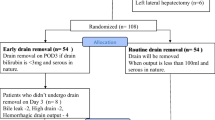Abstract
Purpose
Traditionally, abdominal drainage (AD) is routinely inserted in patients after liver transplantation (LT) to drain ascites and to detect postoperative hemorrhage and bile leakage. However, the benefit of this surgical practice remains a matter of debate regarding potential drainage-associated morbidities.
Methods
In a retrospective pair-matched analysis in a 1:1 ratio, 116 patients after LT were assessed with regards to benefits and risks of abdominal drainage under immunosuppression, respecting model for end-stage liver disease (MELD), age, and gender.
Results
The indications for LT were comparable between the drain and the no-drain group. There was an increased rate of early bile leakage in patients with abdominal drainage (13.8 vs. 1.7 %, p = 0.032). In addition, a significantly higher incidence of infections requiring antibiotic therapy was observed in the drain group (63.8 vs. 39.7 %, p = 0.015). The contribution of drains as a diagnostic tool was marginal, as in the drain group, other diagnostic tools than the drain itself confirmed 50 % of all early bile leakages and 60 % of postoperative hemorrhages. Overall, there was no difference regarding the incidence of incisional hernia after LT (8.6 vs. 10.3 %, p = 1.000), length of hospital stay (22.9 ± 18.7 vs. 18.6 ± 18.6 days, p = 0.215), and 1- and 5-year patient (p = 0.981) and graft survival (p = 0.092).
Conclusions
Equal results can be achieved with or without an abdominal drain in recipients with whole-liver grafts in spite of an increased risk of postoperative infection and biliary leakage in the former group. A benefit of AD as a diagnostic tool could not be demonstrated.

Similar content being viewed by others
References
Fernandez-Aguilar JL, Suarez Munoz MA, Santoyo Santoyo J et al (2010) Is liver transplantation without abdominal drainage safe? Transplant Proc 42:647–648
Kluger MD, Memeo R, Laurent A et al (2011) Survey of adult liver transplantation techniques (SALT): an international study of current practices in deceased donor liver transplantation. HPB (Oxford) 13:692–698
Pianon P, Lise M (1992) Exteriorization of an ovary: an unusual complication of abdominal drainage. Br J Surg 79:963
Poon CM, Leong HT (2009) Abdominal drain causing early small bowel obstruction after laparoscopic colectomy. JSLS 13:625–627
Kawai M, Tani M, Terasawa H et al (2006) Early removal of prophylactic drains reduces the risk of intra-abdominal infections in patients with pancreatic head resection: prospective study for 104 consecutive patients. Ann Surg 244:1–7
Tokunaga Y, Nakayama N, Nishitai R et al (1998) Effects of closed-system drain in surgery: focus on methicillin-resistant Staphylococcus aureus. Dig Surg 15:352–356
Yamazaki S, Takayama T, Moriguchi M et al (2012) Criteria for drain removal following liver resection. Br J Surg 99:1584–1590
Koch M, Garden OJ, Padbury R et al (2011) Bile leakage after hepatobiliary and pancreatic surgery: a definition and grading of severity by the International Study Group of Liver Surgery. Surgery 149:680–688
de Rougemont O, Dutkowski P, Weber M, Clavien PA (2009) Abdominal drains in liver transplantation: useful tool or useless dogma? A matched case–control study. Liver Transpl 15:96–101
Gurusamy KS, Naik P, Davidson BR. Routine drainage for orthotopic liver transplantation. Cochrane Database Syst Rev 2011; CD008399.
Baldini E, Gugenheim J, Ouzan D et al (1999) Orthotopic liver transplantation with and without peritoneal drainage: a comparative study. Transplant Proc 31:556–557
Fernandez-Aguilar JL, Suarez-Munoz MA, Sanchez-Perez B et al (2012) Liver transplantation without abdominal drainage. Transplant Proc 44:2542–2544
Watt KD, Pedersen RA, Kremers WK et al (2010) Evolution of causes and risk factors for mortality post-liver transplant: results of the NIDDK long-term follow-up study. Am J Transplant 10:1420–1427
Fishman JA (2007) Infection in solid-organ transplant recipients. N Engl J Med 357:2601–2614
Liu CL, Fan ST, Lo CM et al (2004) Abdominal drainage after hepatic resection is contraindicated in patients with chronic liver diseases. Ann Surg 239:194–201
Belghiti J, Kabbej M, Sauvanet A et al (1993) Drainage after elective hepatic resection. A randomized trial. Ann Surg 218:748–753
Fong Y, Brennan MF, Brown K et al (1996) Drainage is unnecessary after elective liver resection. Am J Surg 171:158–162
Nosaka T, Bowers JL, Cay O, Clouse ME (1999) Biliary complications after orthotopic liver transplantation in rats. Surg Today 29:963–965
Tanaka K, Kumamoto T, Nojiri K et al (2012) The effectiveness and appropriate management of abdominal drains in patients undergoing elective liver resection: a retrospective analysis and prospective case series. Surg Today
Conflicts of interest
None.
Authors’ contributions
CS: study concept and design, acquisition of data, analysis and interpretation of data, writing paper. TS: study concept and design, analysis and interpretation of data, writing paper, critical revision of manuscript. GG: acquisition of data, critical revision of manuscript. GS: acquisition of data, critical revision of manuscript. SFS: acquisition of data. FM: acquisition of data. GAB: study concept and design, analysis and interpretation of data, writing paper, critical revision of manuscript.
Author information
Authors and Affiliations
Corresponding author
Rights and permissions
About this article
Cite this article
Schwarz, C., Soliman, T., Györi, G. et al. Abdominal drainage after liver transplantation from deceased donors. Langenbecks Arch Surg 400, 813–819 (2015). https://doi.org/10.1007/s00423-015-1338-3
Received:
Accepted:
Published:
Issue Date:
DOI: https://doi.org/10.1007/s00423-015-1338-3



